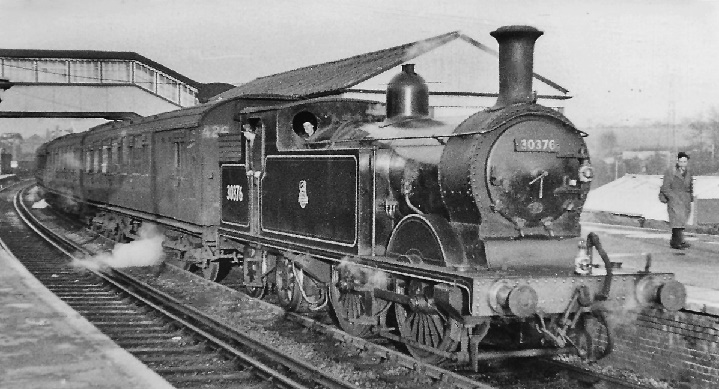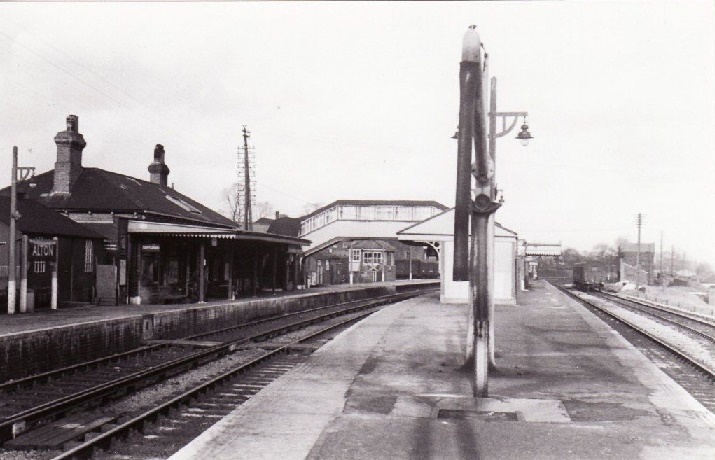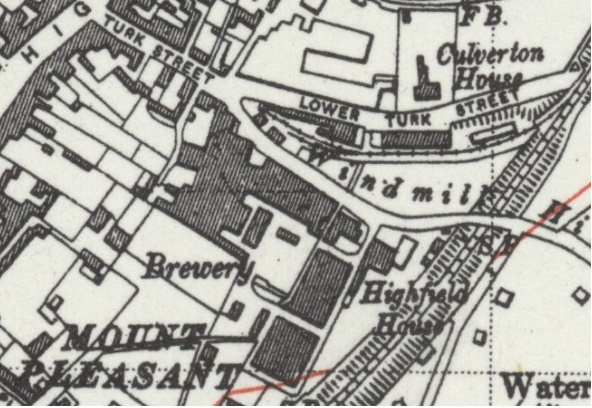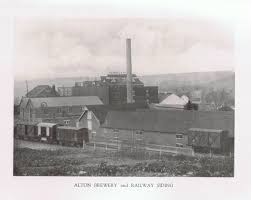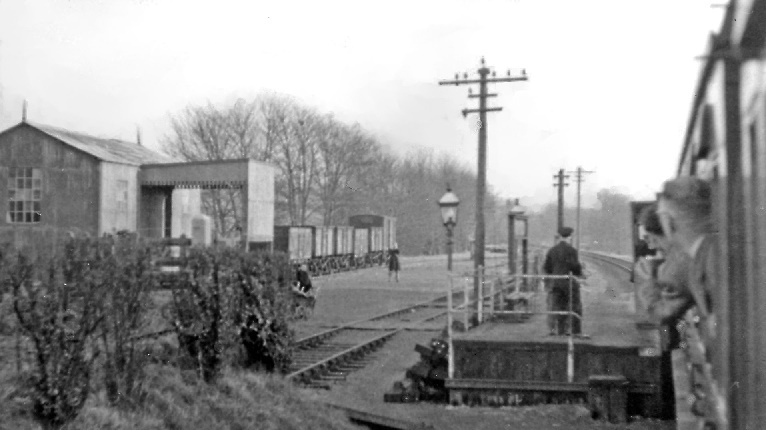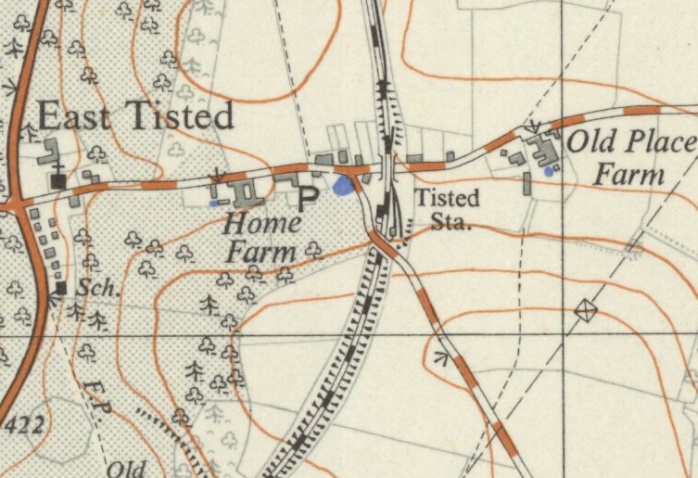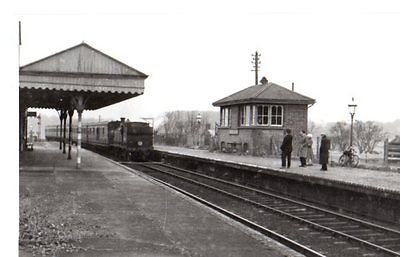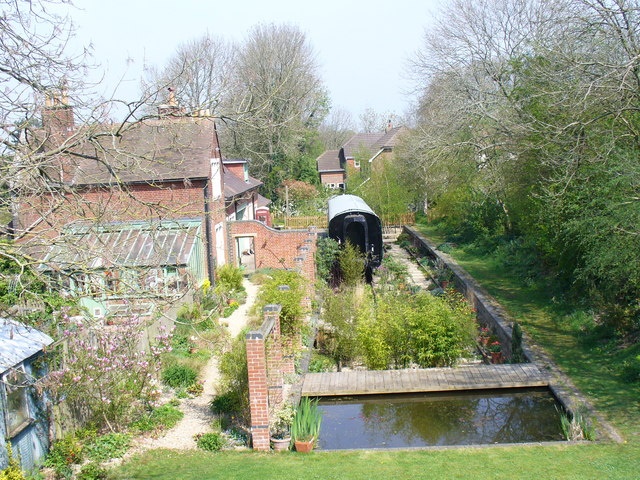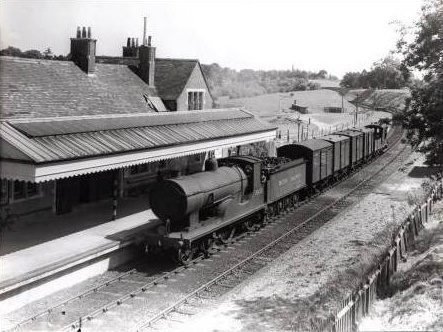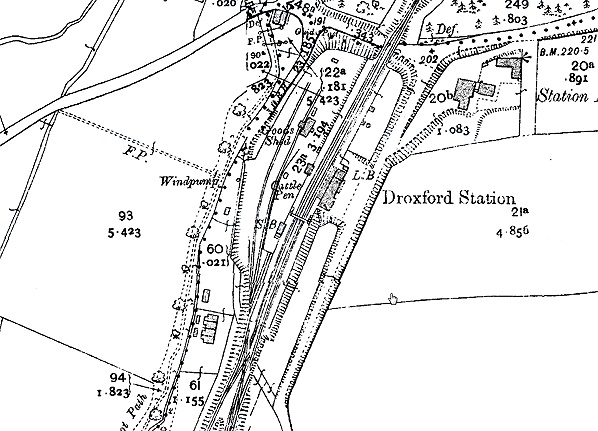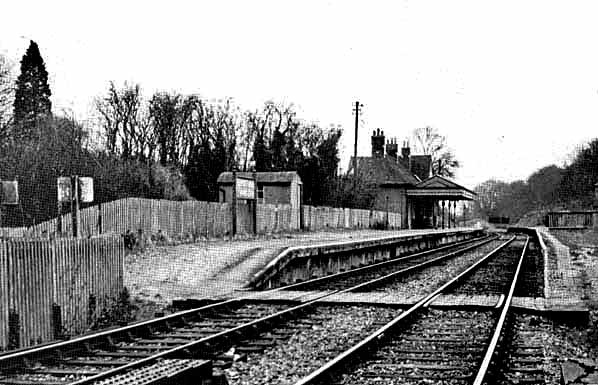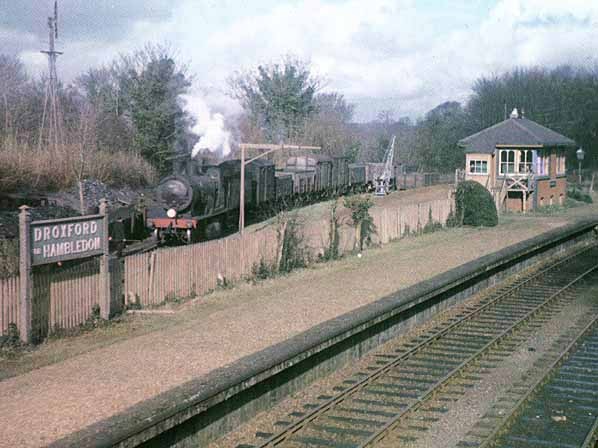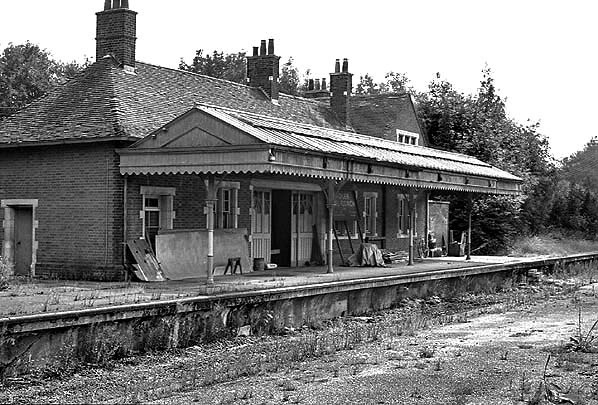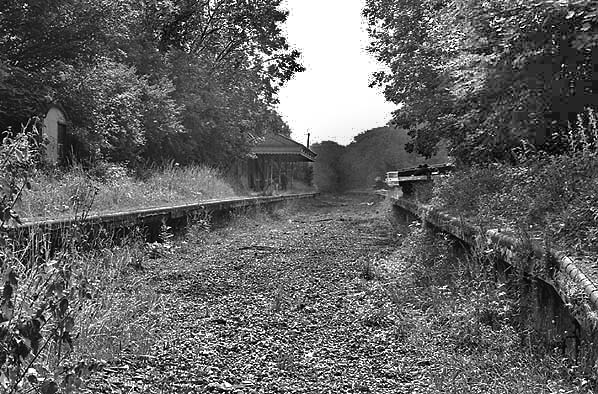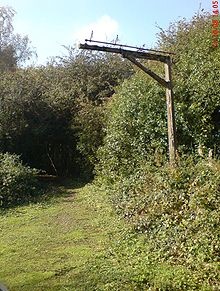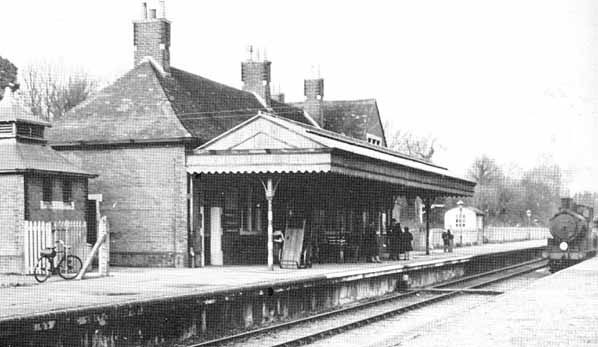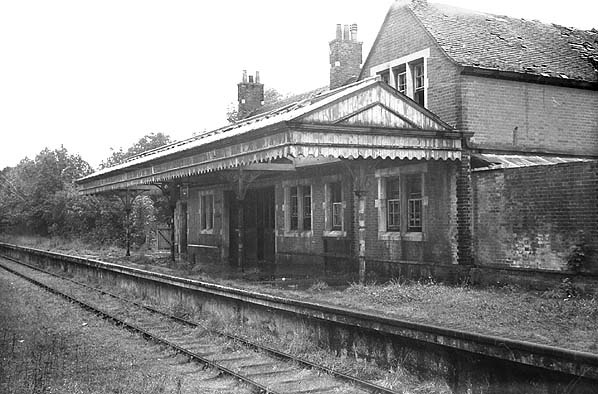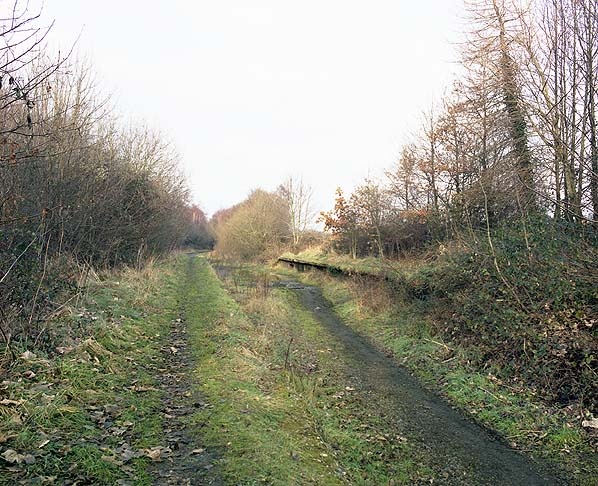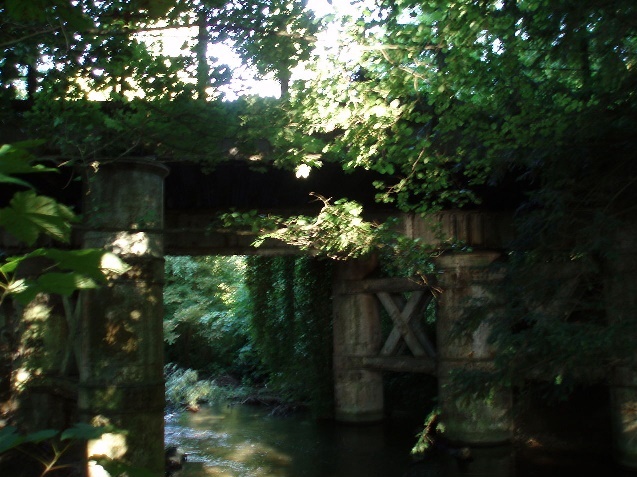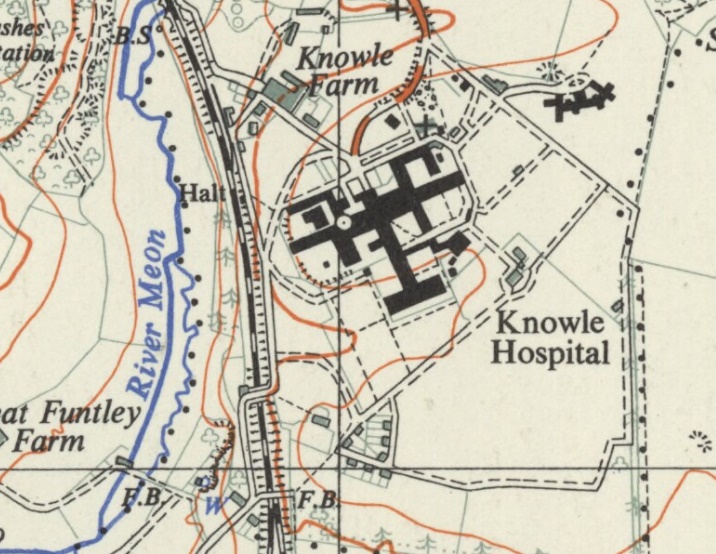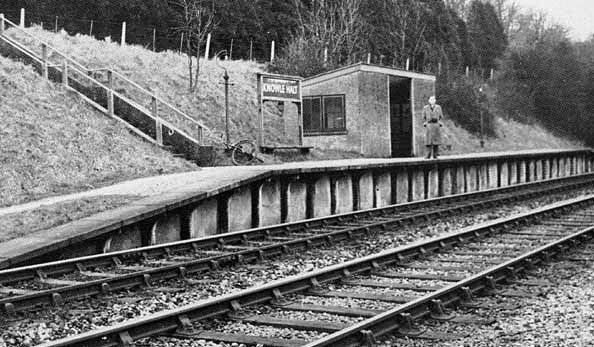Click here for other railways.
Meon Valley RailwayThe Meon Valley Railway (MVR) was a cross-country railway between Alton and Fareham, closely following the course of the River Meon. At its northern (Alton) end, it joined with the Mid-Hants Railway to Winchester, the Alton Line to Brookwood and the Basingstoke and Alton Light Railway. At Fareham it linked with the Eastleigh to Fareham Line, the West Coastway Line and the line to Gosport. The railway was opened in 1903, making it one of the last railways of any size to be built to main-line standards in the United Kingdom.
There were several plans for railways in the Meon Valley in the middle and late 19th century. The Meon Valley formed one of the most direct routes from London to Portsmouth, but the original South Western Main Line went via Basingstoke because of a planned connection with another line heading towards Bristol.
1851 – The Alton & Petersfield Railway was proposed. It would have run from Alton to Petersfield, with another line from Petersfield to Havant and a third from Petersfield to Fareham.
1864 – The LSWR was actually granted an Act of Parliament to build a line from Ropley on the Mid-Hants Railway through West Meon and Warnford, before joining with the still-proposed Petersfield-Bishop's Waltham Line.
1881 – The Windsor, Aldershot & Portsmouth Railway was proposed, which would run from Farnham, westward to East Tisted, then down the Meon Valley to West Meon, where it would turn east over the South Downs through Hambledon before reaching the lines into Portsmouth at Cosham. The proposal had the support of the Army and the Royal Navy but failed to find financial backers and never progressed.
1895 – A proposal was put forward to build a line connecting the Basingstoke to Portsmouth. This was opposed by the London and South Western Railway (LSWR) and the London, Brighton and South Coast Railway. Had the line been built, it would have given the Great Western Railway access to Portsmouth. The bill was rejected in the House of Lords on grounds that it was too costly. The LSWR responded by promising to connect Alton with Basingstoke and Fareham. The Basingstoke and Alton Light Railway was built in 1901.
When planning the construction of the railway, provision was made for upgrading the line to main-line standards, with a ruling gradient of 1-in-100 and only gentle curves. Stations would be constructed with 600-foot long platforms capable of taking 10-coach trains. The LSWR's promotional material for the line showed the line as a direct London-Gosport route for express services. As befitting a railway built to full standards, the stations were impressive. With leanings towards the Arts and Crafts movement, the stations were built out of brick in a mock-Tudor style, with Portland Stone mullions and gables. The architecture included stained-glass door windows and tiled interiors. The lavatories were in outbuildings styled like Chinese pagodas. Goods yards were planned for Mislingford (mainly to serve a local pumping station) and Farringdon, and all the stations had goods sidings, an ornate corrugated iron goods shed and hand-operated cranes to allow parcels and goods to be picked up and dropped off as needed.
Due to both the requirements for gentle gradients and the hilly terrain of the Meon Valley the line required some impressive engineering works, including two tunnels and a 62-foot high viaduct at West Meon. As was not unusual with railway construction, due to the constraints of the landscape, a few of the stations were some distance from the settlements they claimed to serve (especially Privett and East Tisted). At the time, several commentators pointed out that these stations were in fact much better placed to serve the large country houses in the area (Basing Park and Rotherfield Park respectively). This point was further emphasised by the naming of the stations. Stations were usually named after the parish they were built in, but the owner of Basing Park insisted the LSWR name the station Privett (instead of the intended name of 'West Tisted') after the much smaller village in the area, next to which his estate was sited.
Construction began in 1898, with the first soil being cut just south-east of Farringdon. The first task was the laying out and excavating the cuttings to provide material for building up the embankments. The embankments, tunnels, rails, stations, bridges and other structures were then built, with the construction teams starting at the Alton end of the line and moving south. Initially the terrain was easy, with only minimal earth-moving required (considering that the majority of work was done by manual labour). The main problem was obtaining a water supply for both the men and the small steam locomotives used for hauling supplies, since the railway was passing along chalk soil. The further south the railway came, the more undulating the terrain became and greater works of civil engineering were required to maintain the strict gradient requirements of the railway.
West Meon station was the only point on the line where trains could take on water. A deep artesian well was sunk into the hills east of the station and piped to a tank in the station's goods yard to supply a water column on each platform. West Meon was also chosen as the site of the temporary 'village' of wooden huts to provide accommodation for the navvies and their families. A smaller collection of huts had been built at Privett.
South of Droxford, the workers encountered the Reading Beds – an area of clay and gravel that, as part of the larger Fareham Clay Beds, made the area a centre for brickmaking. However, the soil was highly unstable – when wet it was almost liquid, whilst in the summer it was as difficult to work as concrete. Huge amounts of chalk soil excavated from the two tunnels were brought in to stabilise the trackbed and to build embankments, but throughout the life of the railway subsidence was a problem along this stretch. The clay soil also led to standing water and flooding during heavy rain, and a number large grilled drains were provided along the line between Mislingford and Knowle. The problem was so severe in a cutting just north of Wickham that a concrete retaining wall was needed to support the side of the cutting and to prevent flooding the cutting was deepened to allow the construction of foundations of large concrete blocks for trackbed, on top of which were piled bricks to allow drainage before the topsoil and ballast could be laid. To improve the stability of the track itself the section between Wickham and Droxford used concrete sleepers- an early adoption of these on a British railway.
The line then passed through the Forest of Bere before heading across the water-meadows at Wickham on an embankment. Finally, the railway gradually dropped to the natural ground level to the south of Wickham, joining the Eastleigh to Fareham Line just north of the Knowle Hatches Viaduct. Trains from the Meon Valley then passed down this line and into a newly built platform at Fareham station.
The construction of the MVR also included the building of a 2-mile stretch of line between Fareham and Knowle Junction to bypass the Fareham Tunnel, which had suffered serious subsidence problems due to being built through the local clay beds. The tunnel frequently had to be closed for maintenance and shoring-up, so a bypass line was urgently required, especially given the anticipated increase in traffic caused by the new line. The double-track line ran through the north of Fareham and the village of Funtley, re-joining the main line just south of Knowle Hospital. Construction of this line took place once the Meon Valley Railway was completed, starting in 1904 and being completed in 1906.
As was expected in such an agricultural region, the bulk of traffic came from shipping agricultural produce. On the MVR this included watercress, wheat, fruit (especially strawberries and apples), milk and cattle. The LSWR put on special market-day trains, with both passenger carriages and livestock cars, allowing farmers to accompany their livestock. There were local 'pick-up/set-down' goods services along the line, which called at every station to deliver and pick up any waiting goods. No shunting engines were stationed on the MVR, so the locomotive working the train had to uncouple at each station and marshal wagons into and out of the train as required- standard practice for a rural line. Heavier freight services were often powered by locomotives such as the Drummond 700 Class.
Many local newspapers were impressed by the line's speed, the scale of its engineering works, the high standards of the stations and other structures and the beauty of the scenery it passed through. Then, as now, the link between the Meon Valley and the famous figures of Gilbert White and Jane Austen was made several times. Some papers wrote articles describing the route and its scenery in great detail, pointing out places of interest along the line, such as the hill fort at Old Winchester Hill.
Following the opening of the Fareham Tunnel deviation line in 1906 the original route through the tunnels was closed to allow major repairs that ultimately led to the existing tunnels being stripped out and new linings being built. During this period all traffic north of Fareham used the new double-track bypass route. With the tunnels completed the track was relaid with a new layout. Knowle Junction ceased to be a true junction as the connection between the MVR and the Eastleigh to Fareham Line was removed, although the signal box was still used to hand over and collect the Tokens to MVR trains. The MVR now had a totally separate but parallel single-track line across the Knowle Hatches Viaduct (which was widened to triple-track width) and through the tunnels. In true MVR style this route was laid out to allow conversion to double track in the future. The route from Eastleigh continued down the deviation line, joining the original track just north of Fareham Station. This layout was intended to allow fast services from the MVR unrestricted access to Fareham and Gosport without the possibility of being held up at Knowle. Unfortunately, the expected London through-traffic never materialised, and after only a few years the London to Gosport services were cut back. Similarly, the tourist traffic to Stokes Bay also failed to grow, with steamers preferring the more established ports at Portsmouth and Southampton. Since the railway opened, there had been calls for a station at Farringdon, just south of Alton. A goods yard for loading agricultural produce was already sited there, and in 1930 a short wooden platform of one coach-length was built to serve the village. Requests for a similar platform and yard at Meonstoke were not acted on, although the planners of the line had allowed for the future construction of a yard at that location. In 1931 a further down-grading of the MVR took place when the track at Butts Junction (the approach to Alton station) was re-laid. The signal box was removed and the MVR's direct connection with the Alton Line to London was removed, meaning that MVR trains now ran direct to a bay platform at Alton station. It also meant that trains could not run direct from the Alton Line to the Meon Valley as they had been able to- if this was required trains had to shunt from one line to the other. This change spelt the end of the MVR as an integrated part of the railway network- it was now simply handling stopping local traffic with none of the fast inter-city express traffic that the line was built to handle and that used the line in its early days. The Alton Line was converted to electric operation in 1937. It was decided that it was not viable to electrify the MVR, and with that decision went any realistic hope of the line being upgraded to the dual-track standards to which it was built (indeed, the railway would remain single-line for its whole existence).
The MVR had one crucial role to play in the D-Day operations. On 2 June 1944, Winston Churchill, the Prime Ministers of Canada and South Africa, William Lyon Mackenzie King and Jan Smuts, and other Allied leaders arrived in a special train at Droxford Station (the train was actually part of the Royal Train from the London, Midland & Scottish Railway) for a crucial meeting at the nearby HQ of U.S. General Dwight D. Eisenhower the Supreme Allied Commander at Southwick House. The station possessed the longest siding in southern England (outside the railway works at Eastleigh) and was close to a deep cutting. If threatened by an air raid, the train could be pushed into the relative safety of the cutting. During this meeting, final decisions regarding the planning of Operation Overlord were made. A photograph of several of the 'World Leaders' (including Eisenhower) was used to spuriously claim that the meeting had taken place at Droxford itself. The picture has since been identified as Ascot railway station. In 1944 – Around the time of the Allied leaders' meeting at Droxford, a proposal was made for the USATC to build a branch from Droxford to Southwick House. The success of the Allied invasion of Europe in 1944 meant that this plan was never carried out.
Photos and videos of the Meon Valley Line today
Photos 1
Photos 2
Google images
Videos
Alton Station
The first station opened by the London and South Western Railway in 1852 was sited on what is now the station car park. It closed when the present station opened in 1865.
The station is the terminus for two railway lines; the Alton Line which runs to Brookwood and onto London Waterloo and the Mid Hants Watercress Railway, which runs to Alresford. The latter once ran through to Winchester but was closed to passengers in 1973. It reopened as a heritage line in 1985. Two other routes (both now closed) also served the station – the Meon Valley line to Fareham and the Basingstoke and Alton Light Railway.
The inter-war period included the electrification of the London line as far as Alton in 1937, making it a terminus of the electric train service to London. Meanwhile, following the second closure of the Basingstoke & Alton Light Railway in 1936/37, Butts Junction was rationalised. Trains going to Winchester used the right-hand track in both directions, and trains going along the Meon Valley line to Fareham used the left-hand track in both directions. This removed the need for the signal box and points at Butts Junction, effectively making the double track section into two bi-directional single lines which diverged from the platforms at the southern end of Alton station.
Alton Station map early 1900s.
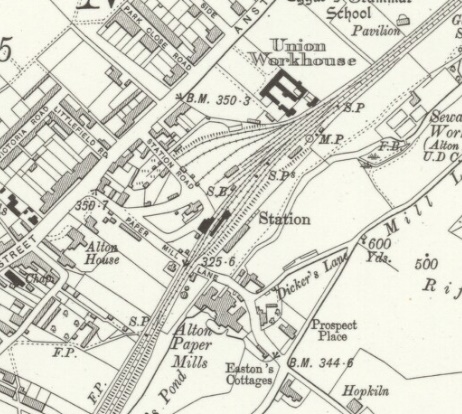
Alton Brewery
Alton Brewery had its own sidings.
Butts Junction
Butts Junction was a railway junction where the Basingstoke and Alton Light Railway, and the Meon Valley Railway diverged from the Mid-Hants line from Alton to Winchester.
Butts Junction map early 1900s.
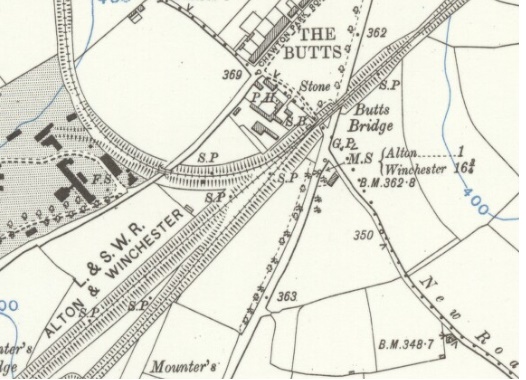
Butts Junction early 1900s and today.
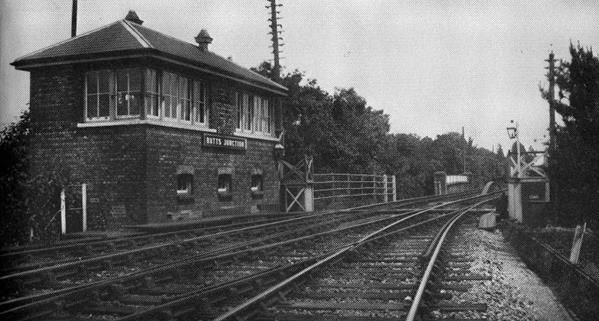
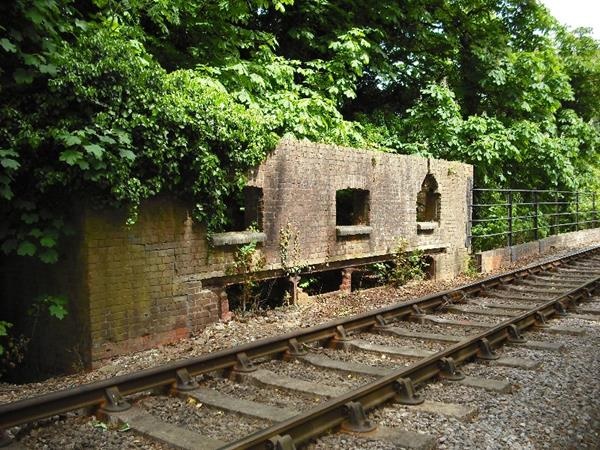
Farringdon Halt
A goods yard for loading agricultural produce was already sited there, and in 1930 a short wooden platform of one coach-length was built to serve the village. Opened in 1931, and 1932 until 1934 was named Faringdon Platform, before reverting to the original name of Farringdon Halt. Closed in 1955 but the sidings were used intermittently for goods traffic 1968.
Farringdon Sidings map early 1900s.
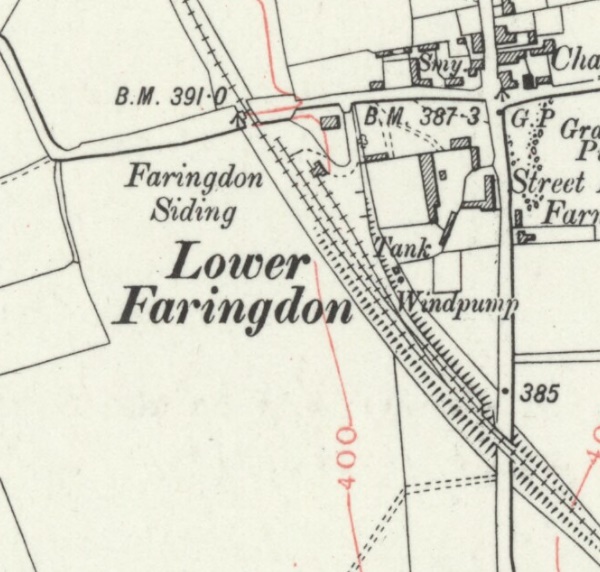
Tisted Station
Opened in 1903. Closed in 1955.
Privett Station
Opened in 1903. Closed in 1955.
It was originally to be named 'West Tisted', following the convention that stations were named after the parish they were in. The family that owned Basing Park, the country estate on the edge of which the station was sited, insisted on the station being named Privett after the hamlet that formed part of their estate. This matter, coupled to the station being sited far from any local settlements but close to the Basing Park house, led many to conclude that the station was built specifically for the owners of the Park. The fact that a new Carriage Drive was built leading from the house to the station only led credence to this rumour.
Privett Station map mid 1900s.
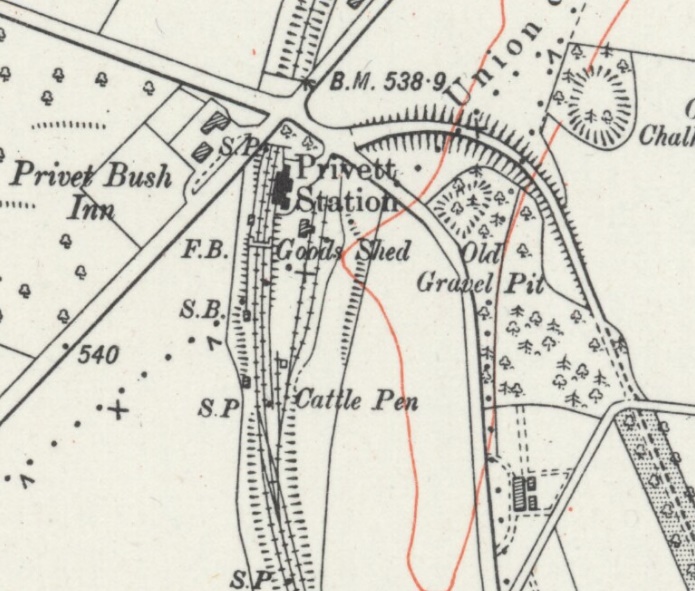
West Meon Station
Opened in 1903. Closed in 1955.
West Meon Station map mid 1900s.
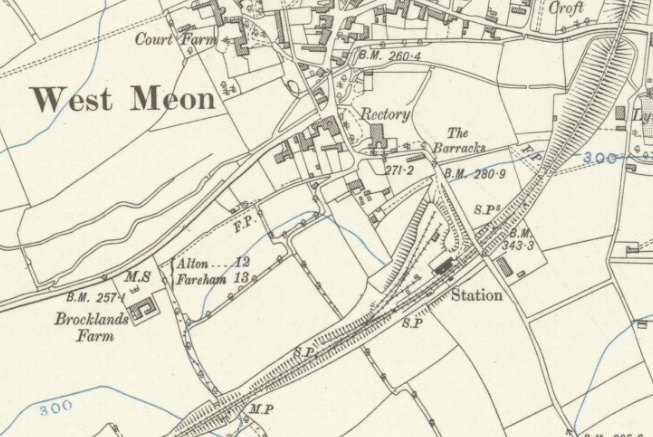
West Meon Station and Yard 1906.
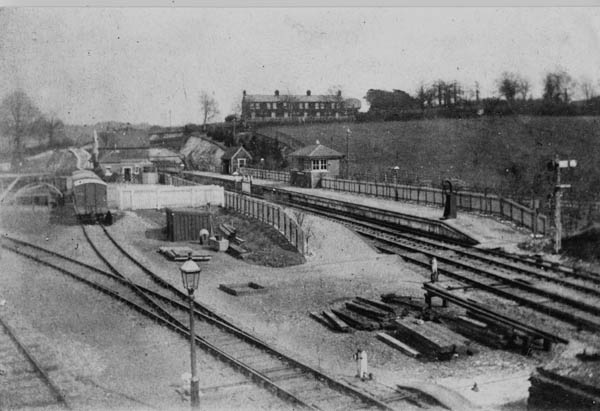
West Meon Station early 1900s.
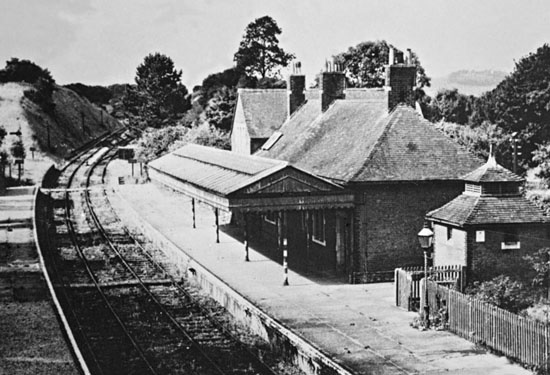
West West Meon Viaduct early 1900s.
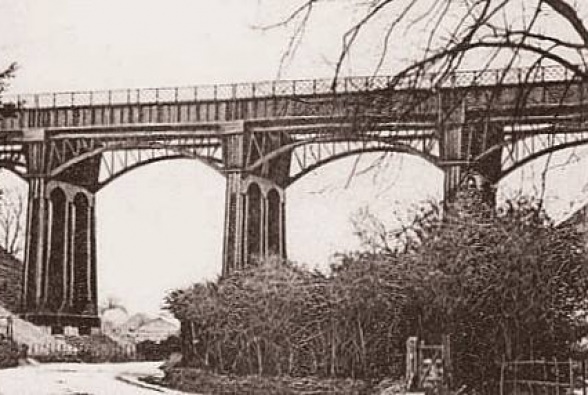
Droxford Station
Opened in 1903. Closed to passengers in 1955. but goods traffic remained on two severed sections of the line. At the north end traffic continued to Farringdon and at the south to Droxford. The track in-between was lifted. The goods service to Wickham and Droxford finished in 1962 while that to Farringdon continued until 1968.
On the 2nd June 1944, Winston Churchill, members of his war cabinet and the Overlord commanders including US President Eisenhower and the French leader Charles de Gaulle, the Canadian President William Lyon McKenzie King and the South African leader Jan Smuts, all met on the Royal train, in the siding at Droxford. Tens of thousands of troops were already camped throughout the area, preparing for the invasion of France. The leaders went on a morale boosting visit to the troops and then returned to the train to hold last minute talks about the invasion plans. Droxford station was chosen as the meeting point because of its proximity to the troops, its secluded siding and proximity to a deep cutting. It was thought that in the event of an attack, the train could be pushed into the cutting, where it would be hard to see.
Mislingford Goods Yard
Located between Wickham and Droxford.
Mislingford Goods Yard map mid 1900s.
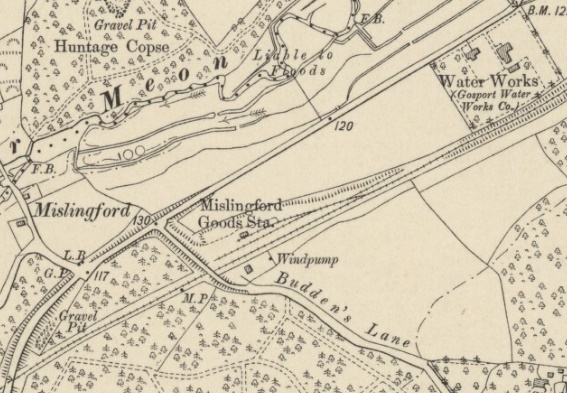
Wickham Station
Opened in 1903. Closed to passengers in 1955. but goods traffic remained on two severed sections of the line. At the north end traffic continued to Farringdon and at the south to Droxford. The track in-between was lifted. The goods service to Wickham and Droxford finished in 1962 while that to Farringdon continued until 1968.
Wickham Station map mid 1900s.
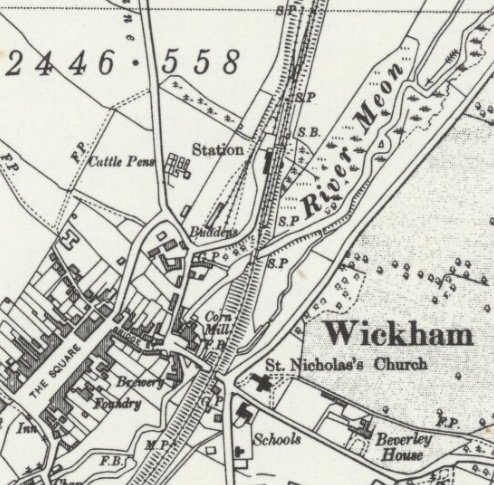
Knowle Junction
..
Knowle Junction and Viaduct map mid 1900s.
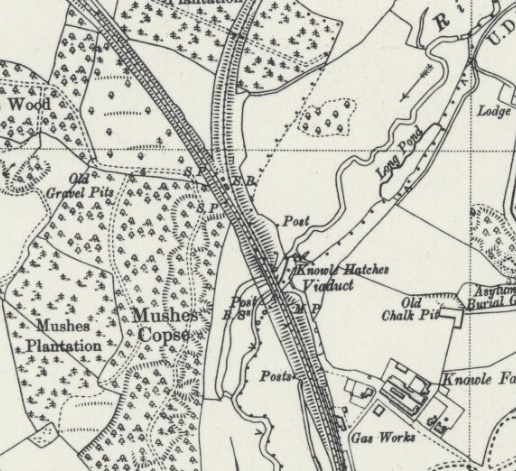
Knowle Halt
The station was built in 1907 to serve Knowle Asylum (previously known as the Hampshire County Lunatic Asylum and later Knowle Hospital) and has been known as Knowle Asylum Halt & Knowle Platform being renamed Knowle Halt in1942. It was closed in1964. Fareham Station
Fareham station was first opened by London and South Western Railway (L&SWR) in 1841 on the line from Eastleigh to Gosport. Later additions connected Fareham station with Southampton, Portsmouth and along the coast towards Brighton.
In 1845 the London, Brighton & South Coast Railway obtained an Act to build a line extending their Brighton to Chichester line to Portsmouth. Perceiving this as a threat to their traffic in the neighbourhood, the London & South Western Railway entered into negotiations with the Brighton company, as a result of which it was agreed that the South Western would build a connecting line from Fareham to a joint station at Cosham and that the line from Cosham to Portsmouth would be a joint LB&SC/L&SW line. Trains from Brighton to Portsmouth commenced on 14 June 1847. The Fareham to Cosham line opened on 1 September 1848, and L&SWR trains began running trains through to Portsmouth on 1 October 1848.
Below is a map of Fareham Station showing the Portsmouth, Southampton, Gosport and Eastleigh/Meon Valley lines. Also shown is the current tunnel route north to Knowle and the old Deviation Line which was built as an alternative route when the tunnel became unsafe and finally collapsed in the late 1800's. The tunnel was re-opened in 1903 and the Deviation Line finally closed off in 1973.
Fareham Station map mid 1900s.
Fareham Junction map mid 1900s.
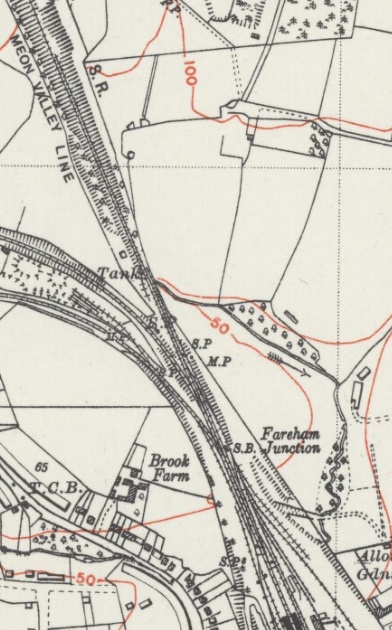
Fareham Viaduct on opening day, 1 September 1848.
References:
Wikipedia - Alton Station
Wikipedia - Farringdon Halt
Wikipedia - Privett
Wikipedia - West Meon
Disused Stations - Droxford
Disused Stations - Wickham
Disused Stations - Knowle Halt
Wikipedia - Meon Valley Railway
John Speller's Web Pages
Old Maps Online
